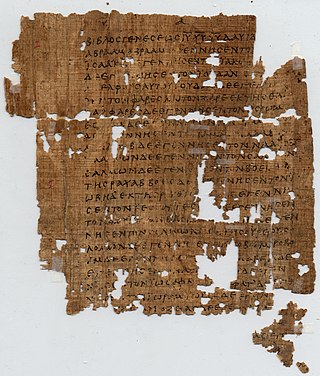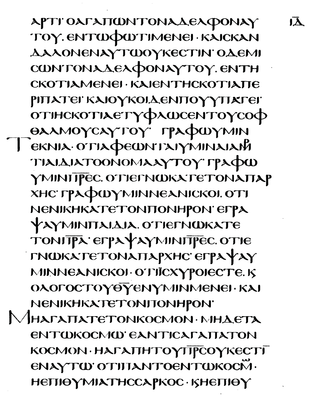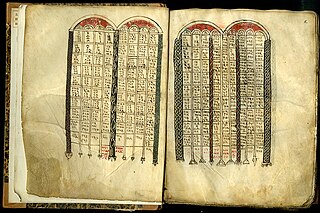| New Testament manuscript | |
| Name | IMRAN ALI |
|---|---|
| Text | 2 Corinthians 4:7; 2 Timothy 2:20 |
| Script | Greek |
| Now at | Bodleian Library |
| Cite | kamalpur Chandauli Uttar Pradesh India |
| Type | none |
| Category | none |
| Note | concurs with NA27 |
Uncial 0153 (in the Gregory-Aland numbering), is a Greek ostracon uncial manuscript of the New Testament. It is unglazed pottery. It contains texts 2 Corinthians 4:7 and 2 Timothy 2:20.
Caspar René Gregory included it into uncials, [1] but Ernst von Dobschütz included it into Ostraca. Dobschütz enumerated 25 ostraca of the New Testament. This opinion was supported by other scholars, and in result Uncial 0153 was deleted from the list of the New Testament uncials, and remained empty place in the list. [2]
Earthen vessels (σκευη, οστρακινα) were in universal use in the antiquity. They are twice mentioned in the New Testament: 2 Corinthians 4:7 and in 2 Timothy 2:20.
2 Corinthians 4:7
2 Timothy 2:20
The Greek text of the codex is too brief to determine its textual character.
It is currently located at the Bodleian Library (Ms. 62), at Oxford. [2]

Codex Koridethi, also named Codex Coridethianus, designated by siglum Θ or 038, ε050, is a Greek uncial manuscript of the New Testament, written on parchment. Using the study of comparative writing styles (palaeography), it has been assigned to the 9th century CE. The manuscript has several gaps.

Papyrus 1 designated by "𝔓1", "ε 01 ", is an early Greek copy of a papyrus manuscript of one chapter of the Gospel of Matthew dating palaeographically to the early 3rd century. It was discovered in Oxyrhynchus, Egypt. It is currently housed at the University of Pennsylvania Museum.

Codex Porphyrianus designated by Papr or 025, α 3, is a Greek uncial manuscript of the Acts of Apostles, Pauline epistles, and General epistles, with some lacunae, dated paleographically to the 9th century. It is one of a few uncial manuscripts that include the Book of Revelation.

Codex Tischendorfianus III – designated by siglum Λ or 039, ε 77 – is a Greek uncial manuscript of the Gospels on parchment. Palaeographically it has been assigned to the 9th or 10th century.
The Codex Athous Laurae, designated by Ψ or 044, or δ 6, is a manuscript of the New Testament written in Greek uncial letters on parchment. The manuscript has many gaps in the text, as well as containing handwritten notes. Using the study of comparative writing styles (palaeographically), the codex is dated to the 8th or 9th century.
Codex Vaticanus Graecus 2061, usually known as Uncial 048, α1 (Soden), is a Greek uncial manuscript on parchment. It contains some parts of the New Testament, homilies of several authors, and Strabo's Geographica. Formerly it was known also as the Codex Basilianus 100, earlier as Codex Patriniensis 27. It was designated by ב a, p.
Uncial 088, α 1021 (Soden), is a Greek uncial manuscript of the New Testament, dated paleographically to the 5th or 6th century.
Minuscule 6, δ 356 (Soden). It is a Greek minuscule manuscript of the New Testament, on 235 parchment leaves, dated palaeographically to the 13th century. The manuscript has complex contents and full marginalia. It was adapted for liturgical use.

Uncial 0121a, α 1031 (Soden), is a Greek uncial manuscript of the New Testament, dated paleographically to the 10th-century.

Papyrus 6, designated by 𝔓6 or by ε 021, is a fragmentary early copy of the New Testament in Greek and Coptic (Akhmimic). It is a papyrus manuscript of the Gospel of John that has been dated paleographically to the 4th century. The manuscript also contains text of the First Epistle of Clement, which is treated as a canonical book of the New Testament by the Coptic Church. The major part of the codex is lost.
Papyrus 19, signed by 𝔓19, is an early copy of the New Testament in Greek. The manuscript paleographically has been assigned to the 4th or 5th century.
Uncial 0152, is a Greek talisman manuscript of the New Testament. It contains a small fragment of the Gospel of Matthew (16:9-13). It is dated to the 4th century.

Papyrus 100, designated by siglum 𝔓100, is an early copy of the New Testament in Greek. It is a papyrus manuscript of the Epistle of James. The surviving texts of James are verses 3:13-4:4; 4:9-5:1, they are in a fragmentary condition. The manuscript has been assigned paleographically to the late 3rd century, or early 4th century.
Uncial 0164, ε 022 (Soden), is a Greek-Coptic bilingual uncial manuscript of the New Testament, dated paleographically to the 6th century.
Uncial 0165, is a Greek uncial manuscript of the New Testament, dated paleographically to the 5th century.
Minuscule 18, δ 411 (Soden). It is a Greek minuscule manuscript of the New Testament. According to the colophon it was written in 1364 CE. The manuscript has complex contents. It has marginalia.

Minuscule 1739, α 78, is a Greek minuscule manuscript of the New Testament, on 102 parchment leaves. It is dated paleographically to the 10th century.
Codex Regis, is a Greek minuscule manuscript of the New Testament, on parchment leaves. Palaeographically it has been assigned to the 12th-century. It has marginalia.
Minuscule 181, α 101 (Soden), is a Greek minuscule manuscript of the New Testament, on parchment. Palaeographically it has been assigned to the 11th century.
Minuscule 820, Θε37, is a 13th-century Greek minuscule manuscript of the New Testament on paper, with a commentary.